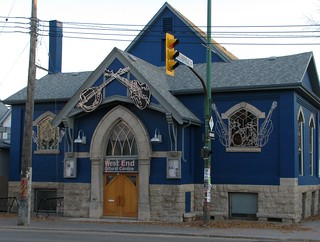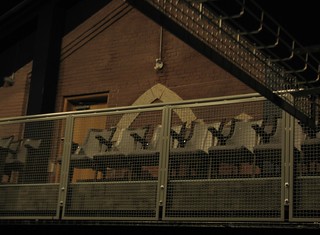Address: 586 Ellice Avenue
Architect: Herbert E. Matthews
Contractor: B. Pattinson and Thomas Eilbeck
Opened: January 10, 1909
The West End Cultural Centre has a long history as a "starter church" for a number of Winnipeg's current congregations. It has been no stranger to concerts and other performances, either !
Top: ca. 1897 (courtesy St. Matthews Church)
Bottom: May 17, 1897, Winnipeg Tribune
Bottom: May 17, 1897, Winnipeg Tribune
St. Matthews Church was founded in 1896 as a mission of Holy Trinity Church. The first services and Sunday school classes were held at the home of Mr. and Mrs. Horace Buley at 448 Mulligan (now Sherbrook) Street. In 1897 the couple donated land at the corner of Ellice and Sherbrook to allow for the construction of the first St. Matthews Church.
The $1,200 structure with a capacity of 350 opened on May 16, 1897. In 1901 St. Matthews received its independence from Holy Trinity. That same year, the building was expanded to include a nave and basement.
The years 1900 – 1906 were busy ones for the West End west of Sherbrook Street. Streetcar tracks were laid on Sherbrook from Portage to Notre Dame Avenues, large sections of land were opened up for residential development and the city ran sidewalks, water and sewer service to the area. As the population exploded, so did the size of St. Matthews’ congregation and Sunday school program. The church was soon bursting at the seams.
The decision was made to build a new, 50' x100' structure on the same site. In September 1908 the congregation said farewell before moving to temporary premises at a nearby warehouse.
Top: ca. 1911 (courtesy: St. Matthews Church)
Bottom: October 19, 1908, Winnipeg Tribune
Bottom: October 19, 1908, Winnipeg Tribune
Architect Herbert E. Matthews' Gothic-inspired design featured red brick with Tyndall stone trim. It had a full basement that would be home to the Sunday school program and the St. Matthews Athletic Club which fielded numerous teams including lacrosse, cricket, hockey and tennis.
The opening service of the $15,000 structure took place on January 10, 1909.
Later that year, it also became a popular site for concerts after a top-of-the-line pipe organ from the Warren Church Organ Company was installed in November.
The growth of St. Matthews' congregation was so great that in just a couple of years they had to contemplate expanding again. This time, they required a larger site and in 1912 construction began at at St. Matthews Avenue and Maryland Street. (For more on the history of St. Matthews Church.)
October 4, 1914, Winnipeg Free Press
In 1914 the building became home to Elim Chapel, a non-denominational congregation formed in 1910, worshipping in a building at Ellice and Beverley. Elim was a popular stop for travelling preachers and sermonists from around the world.
Like St. Matthews, Elim soon outgrew the space and purchased the vacated former St. Stephen's Church on Portage Avenue at Spence Street. The final Elim service was held here on October 27, 1928.
May 16, 1931, Winnipeg Tribune
The next owners were St. Peter’s Evangelical Lutheran Church in 1931. Prior to this, they had been worshiping in the Good Templar's Hall on Sargent Avenue. The interior of the church was extensively remodeled before they held their first service on May 17. In 1969 they bid farewell when their present church on Walnut Street at Wolseley Avenue opened.
From 1939 to 1942 the Henderson Directory lists this address as a "naval barracks". It is possible that the basement was used to house recruits for the Royal Canadian Navy Volunteer Reserve (RCNVR) recruitment centre / HMCS Chippawa located across the street during this time.
March 22, 1973, Winnipeg Free Press
After St. Peter's, the building's run as a place of worship ended. In those sixty years it hosted thousands of religious ceremonies, sermons and concerts with no major incidents or fires reported.
The Portuguese Association of Manitoba opened their first cultural centre there on April 7, 1973. It housed a library, dance and language classes and many live performances. The West End's growing Portuguese community outgrew the hall and in 1987 they left for their new home at Young Street and Notre Dame Avenue.
April 21, 1987, Winnipeg Free Press
The new owners of the building were Mitch Podoluck and Ava Kobrinsky. Podoluck, best known as the founder of the Winnipeg Folk Festival, said that in the late 1970s he had a vision for what a community performing arts space should be, modelled on the early days of the Vancouver East Cultural Centre.
The building was purchased from the Portuguese Association for $131,000. Along with a $75,000 grant from the province and free labour from dozens of dedicated volunteers, it was transformed into the West End Cultural Centre.
Opening night, Friday, October 23, 1987, was a concert by Spirit of the West. The renovations continued until just minutes before curtain time. Other acts in its busy first month included Jesse Winchester (Nov. 1), Loreena McKennitt (Nov. 20), Valdy (Nov. 21, 22) and Connie Kaldor, (Nov 27).
The 300-seat venue was a hit among concert-goers and performers for its intimate feel and great acoustics.
Bottom: Christian Cassidy
In 2003 an engineer's report gave the nearly century-old building's foundation a failing grade. It would need extensive renovations if it was going to enter a second century. Rather than move to a new location, the board decided to stay put and both renovate and build new. The venue closed in summer 2008. While the original structure was gutted and renovated, a new, adjoining 400-seat hall was built to the south. The $4 million renovation project was headed by Prairie Architects.
The new, improved West End Cultural Centre opened on May 25, 2009 with a concert by Hawksley Workman.
Above: Seats at the Rex, 2008
Below: Seats at the WECC, 2010
The West End Cultural Centre was awarded a LEED Silver certification in 2012.
Related:
WECC reopens tonight Winnipeg Free Press, May 25, 2009
Our Story West End Cultural Centre
West End Cultural Centre Prairie Architects















No comments:
Post a Comment